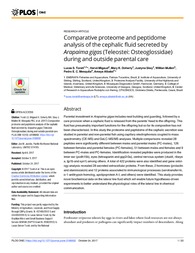Comparative proteome and peptidome analysis of the cephalic fluid secreted by Arapaima gigas (Teleostei: Osteoglossidae) during and outside parental care.
Comparative proteome and peptidome analysis of the cephalic fluid secreted by Arapaima gigas (Teleostei: Osteoglossidae) during and outside parental care.
Author(s): TORATI, L. S.; MIGAUD, H.; DOHERTY, M. K.; SIWY, J.; MULLEN, W.; MESQUITA, P. E. C.; ALBALAT, A.
Summary: Parental investment in Arapaima gigas includes nest building and guarding, followed by a care provision when a cephalic fluid is released from the parents' head to the offspring. This fluid has presumably important functions for the offspring but so far its composition has not been characterised. In this study the proteome and peptidome of the cephalic secretion was studied in parental and non-parental fish using capillary electrophoresis coupled to mass spectrometry (CE-MS) and GeLC-MS/MS analyses. Multiple comparisons revealed 28 peptides were significantly different between males and parental males (PC-males), 126 between females and parental females (PC-females), 51 between males and females and 9 between PC-males and PC-females. Identification revealed peptides were produced in the inner ear (pcdh15b), eyes (tetraspanin and ppp2r3a), central nervous system (otud4, ribeye a, tjp1b and syn1) among others. A total of 422 proteins were also identified and gene ontology analysis revealed 28 secreted extracellular proteins. From these, 2 hormones (prolactin and stanniocalcin) and 12 proteins associated to immunological processes (serotransferrin, α-1-antitrypsin homolog, apolipoprotein A-I, and others) were identified. This study provides novel biochemical data on the lateral line fluid which will enable future hypotheses-driven experiments to better understand the physiological roles of the lateral line in chemical communication.
Publication year: 2017
Types of publication: Journal article
Keywords: Alloparental behavior, Arapaima gigas, Peixe, Peptidome, Pirarucu, Proteome
Observation
Some of Embrapa's publications are published as ePub files. To read them, use or download one of the following free software options to your computer or mobile device. Android: Google Play Books; IOS: iBooks; Windows and Linux: Calibre.
Access other publications
Access the Agricultural Research Database (BDPA) to consult Embrapa's full library collection and records.
Visit Embrapa Bookstore to purchase books and other publications sold by Embrapa.

